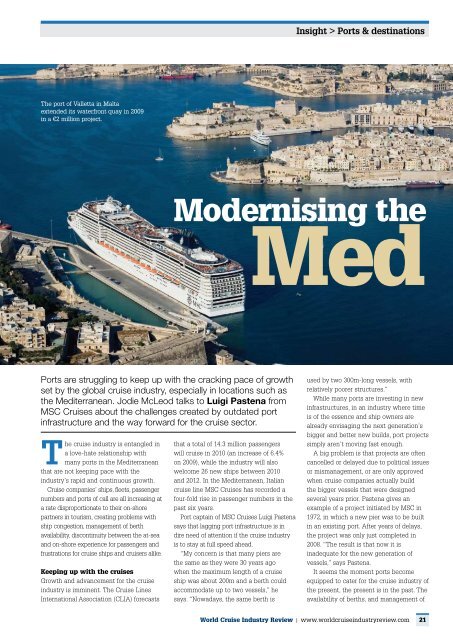Metamorphosis - Cruise Ship Portal
Metamorphosis - Cruise Ship Portal
Metamorphosis - Cruise Ship Portal
Create successful ePaper yourself
Turn your PDF publications into a flip-book with our unique Google optimized e-Paper software.
The port of Valletta in Malta<br />
extended its waterfront quay in 2009<br />
in a €2 million project.<br />
Ports are struggling to keep up with the cracking pace of growth<br />
set by the global cruise industry, especially in locations such as<br />
the Mediterranean. Jodie McLeod talks to Luigi Pastena from<br />
MSC <strong>Cruise</strong>s about the challenges created by outdated port<br />
infrastructure and the way forward for the cruise sector.<br />
The cruise industry is entangled in<br />
a love-hate relationship with<br />
many ports in the Mediterranean<br />
that are not keeping pace with the<br />
industry’s rapid and continuous growth.<br />
<strong>Cruise</strong> companies’ ships, fleets, passenger<br />
numbers and ports of call are all increasing at<br />
a rate disproportionate to their on-shore<br />
partners in tourism, creating problems with<br />
ship congestion, management of berth<br />
availability, discontinuity between the at-sea<br />
and on-shore experience for passengers and<br />
frustrations for cruise ships and cruisers alike.<br />
Keeping up with the cruises<br />
Growth and advancement for the cruise<br />
industry is imminent. The <strong>Cruise</strong> Lines<br />
International Association (CLIA) forecasts<br />
that a total of 14.3 million passengers<br />
will cruise in 2010 (an increase of 6.4%<br />
on 2009), while the industry will also<br />
welcome 26 new ships between 2010<br />
and 2012. In the Mediterranean, Italian<br />
cruise line MSC <strong>Cruise</strong>s has recorded a<br />
four-fold rise in passenger numbers in the<br />
past six years.<br />
Port captain of MSC <strong>Cruise</strong>s Luigi Pastena<br />
says that lagging port infrastructure is in<br />
dire need of attention if the cruise industry<br />
is to stay at full speed ahead.<br />
“My concern is that many piers are<br />
the same as they were 30 years ago<br />
when the maximum length of a cruise<br />
ship was about 200m and a berth could<br />
accommodate up to two vessels,” he<br />
says. “Nowadays, the same berth is<br />
Insight > Ports & destinations<br />
Modernising the<br />
Med<br />
used by two 300m-long vessels, with<br />
relatively poorer structures.”<br />
While many ports are investing in new<br />
infrastructures, in an industry where time<br />
is of the essence and ship owners are<br />
already envisaging the next generation’s<br />
bigger and better new builds, port projects<br />
simply aren’t moving fast enough.<br />
A big problem is that projects are often<br />
cancelled or delayed due to political issues<br />
or mismanagement, or are only approved<br />
when cruise companies actually build<br />
the bigger vessels that were designed<br />
several years prior. Pastena gives an<br />
example of a project initiated by MSC in<br />
1972, in which a new pier was to be built<br />
in an existing port. After years of delays,<br />
the project was only just completed in<br />
2008. “The result is that now it is<br />
inadequate for the new generation of<br />
vessels,” says Pastena.<br />
It seems the moment ports become<br />
equipped to cater for the cruise industry of<br />
the present, the present is in the past. The<br />
availability of berths, and management of<br />
World <strong>Cruise</strong> Industry Review | www.worldcruiseindustryreview.com 21


